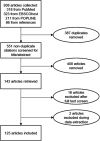Vaccination assessments using the Demographic and Health Survey, 2005-2018: a scoping review
- PMID: 33268412
- PMCID: PMC7713201
- DOI: 10.1136/bmjopen-2020-039693
Vaccination assessments using the Demographic and Health Survey, 2005-2018: a scoping review
Abstract
Objective: To characterise studies which have used Demographic and Health Survey (DHS) datasets to evaluate vaccination status.
Design: Scoping review.
Data sources: Electronic databases including PubMed, EBSCOhost and POPLINE, from 2005 to 2018.
Study selection: All English studies with vaccination status as the outcome and the use of DHS data.
Data extraction: Studies were selected using a predetermined list of eligibility criteria and data were extracted independently by two authors. Data related to the study population, the outcome of interest (vaccination) and commonly seen predictors were extracted.
Results: A total of 125 articles were identified for inclusion in the review. The number of countries covered by individual studies varied widely (1-86), with the most published papers using data from India, Nigeria, Pakistan and Ethiopia. Many different definitions of full vaccination were used although the majority used a traditional schedule recommended in the WHO's Expanded Programme on Immunisation. We found studies analysed a wide variety of predictors, but the most common were maternal education, wealth, urbanicity and child's sex. Most commonly reported predictors had consistent relationships with the vaccination outcome, outside of sibling composition.
Conclusions: Researchers make frequent use of the DHS dataset to describe vaccination patterns within one or more countries. A clearer idea of past use of DHS can inform the development of more rigorous studies in the future. Researchers should carefully consider whether a variable needs to be included in the multivariable model, or if there are mediating relationships across predictor variables.
Keywords: international health services; paediatric infectious disease & immunisation; public health.
© Author(s) (or their employer(s)) 2020. Re-use permitted under CC BY-NC. No commercial re-use. See rights and permissions. Published by BMJ.
Conflict of interest statement
Competing interests: None declared.
Figures



References
-
- Centers for Disease Control and Prevention Ten great public health achievements, 1900– 1999: impact of vaccines universally recommended for children. Morb Mortal Wkly Rep 1999;48:243–8.
-
- World Health Organization Summary of WHO position papers - recommendations for routine immunization, 2017. Available: http://www.who.int/immunization/policy/Immunization_routine_table1.pdf
Publication types
MeSH terms
Associated data
Grants and funding
LinkOut - more resources
Full Text Sources
Medical
Miscellaneous
